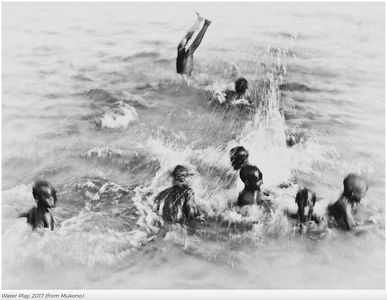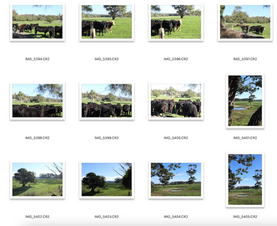P | P2 | AS2: Collecting
- Amber Houbara
- Jun 29, 2024
- 7 min read
Updated: Jan 20
‘Fragments of a vessel which are to be glued together must match one another in the smallest details although they need not be like one another.’
(Walter Benjamin, [1936] 1999, p.79)
The Walter Benjamin quote above expresses the idea that a collection should reflect a single coherent idea, but you’ll also need technical rigour to match the photographs to each other ‘in the smallest details’. Start by choosing your focal length, aperture and viewpoint combination in advance.
Visually, similarities correspond so they’re easy to look at, but be careful of duplicates because repetition is boring. Differences are interesting because they contrast, but randomly changing your framing or allowing a confusion of detail into your backgrounds will distract from the viewing.
Brief
Create a series of between six and ten photographs on one of the following subjects:
Things
Views
Heads
Albert Renger-Patzsch’s photobook ‘The World is Beautiful’ upset Walter Benjamin when it first appeared in 1928 and he railed against it in his famous essay ‘A Short History of Photography’ (easily available on the internet). He thought that this kind of photography denied social contexts – ‘the world is beautiful’ because that’s all you’ve got to say about it. However, Renger- Patzsch’s book was originally called ‘Things’ and rather than present a superficial beauty the point was more to let things speak quietly for themselves.
In ’ひろしま hiroshima’ the Japanese photographer Ishiuchi Miyako takes this approach when photographing clothing and other personal items collected from the atomic bomb site at Hiroshima. The photobook can be seen on Jörg Colberg’s Youtube channel here: https://youtu.be/csVx_QRPvps
In ‘Species’ OCA tutor Andrew Langford recalls the sense of dislocation that he experienced visiting natural history collections as a child,
‘These specimens were very carefully arranged within the total black picture space and, for me, evoked a personal memory as a childof visiting natural history collections and experiencing the highly detached, organizational systems of presentation. These systems seemed so at odds at the time with my real life sense of ‘the natural’ as a fully integrated phenomenon, to which I sensed that I was seamlessly connected’.
Ed Ruscha’s collection of views ‘26 Gasoline Stations’ became another point of origin in photography. If you’re curious about why read around it a little online to gain an understanding of it within its own time. http://www.tate.org.uk/about/projects/transforming-artist-books/summaries/edward-ruscha- twentysix-gasoline-stations-1963
And for a theoretical discussion on the distinction between landscapes and views have a look at ‘Photography’s Discursive Spaces: Landscape/View’ by Rosalind Krauss (also available online).
For ‘Views’ you’ll probably either need a driver or be prepared to do some walking. Either way if you keep the weight of your equipment to a minimum you’ll see more.
From deadpan views to deadpan heads: http://www.bettinavonzwehl.com/
‘The resulting portraits aren’t what you’d normally expect from portraiture. The subjects are not engaging with me or with the camera, it is almost as if they are in a different world’.
(Bettina von Zwehl (2007) p71)
You can find more on von Zwehl’s approach to portraiture in Charlotte Cotton’s ‘The Photograph as Contemporary Art’ that you will have received when you started EYV.
Heads don’t have to be deadpan, or even human. There’s a fair amount of variation in Mårtin Lange’s ‘Citizens’ series but there is no questioning its overall visual coherence: https://martenlange.com/works/citizen/#1
Some of the examples given above are for collections of photographs, others for photographs of collections, but whichever way you go, your set will be stronger if it relates in some way to your interests in life and photography.
Assignment notes
Send your photographs to your tutor accompanied by assignment notes (500–1000 words) introducing and contextualising your work. The photographers and reading above provide starting points for your research for this assignment.
Reflection
Check your work against the assessment criteria for this course before you send it to yourtutor. Make some notes in your learning log about how well you believe your work meets each criterion. Your tutor may take a while to get back to you so carry on with the course while you’re waiting.
Reworking your assignment
Following feedback from your tutor, you may wish to rework some of your assignment, especially if you plan to submit your work for formal assessment. If you do this, make sure you reflect on what you’ve done and why in your learning log.
Research
I started by researching about all the references mentioned on the brief.
Albert Renger-Patzsch’s photobook ‘The World is Beautiful’
I found this book on wikipedia to read about, first of all, as a book designer I love the cover!

"Die Welt ist schön (The World is Beautiful) is a 1928 book of photography by German photographer Albert Renger-Patzsch. A popular work at the time, Die Welt ist schön is generally considered one of the most important books of photography published in the Weimar Republic, and as an iconic example of the photography of New Objectivity.[1]"
Wikipedia.
It got me very interested to learn it is such an important and influential book!
I couldn't find an online copy, but could find other students of photography reviewing his book.
I could see from this student's website, a few shots from the book.
I really love Albert Renger-Patzsch’s work. I love the creative thinking which made him look at the world in such a special way.
I find this very inspiring!
I also love minimalism and the idea of less is more, and I find that even if the frame is 'busy' it is busy with very interesting things, he uses a lot the law of repetition which looks very pleasing.
I disagree with Walter Benjamin's critique of Albert Renger-Patzsch’s work saying it's out of social contexts as I think this is very old thinking, and photography doesn't always have to have social contexts.
I think there is beauty for Albert's work, as you can tell it was photographed by the same person, and they work well together even though they are very different.
’ひろしま
Hiroshima’ the Japanese photographer Ishiuchi Miyako presents in a very minimalistic and japanese like way the items from the Hiroshima atomic bomb. This almost cold like way of presentation, gives space to each item to be experienced by the viewer. I feel like it gives the viewer the space to imagine the person who wore these items and their story.
These items go very well together as the minimalist background and the presentation way holding the part which tight it all together, and the items are the variable which changes.
I couldn't find Andrew Langford's work online and the link from the course workbook didn't work.
Ed Ruscha’s collection of views ‘26 Gasoline Stations’
I absolutely love Ed Ruscha's work. I enjoyed reseaching and looking at other projects he did as well as the gasoline stations. I was inspired from his work very much and it got me interested to shoot views as my topic.
His work with plants made me also be interested to shoot a native Australian plant called grass tree.
I really love as well the presentation of his work in his books and love the fact the plants are isolated from their background.
Eduard Ruscha
'Photography’s Discursive Spaces: Landscape/View’ by Rosalind Krauss
I read some of the article and also further researched about the tecnique of lithographic print as I wasn't familiar with it.
From the research point I really liked Guy Bourdin and this article about him was in a very interesting website 'The Independent Photographer' which sent me to check out other photographers
I also really liked Bastiaan Woudt I find his work very beautiful and I love his aesthetics.
I also found on this website the photographer Rémi Bergougnoux.
I love his views photography, and you can really see his photos work well together, even if they are from other parts of the world and not from the same series.
I also adore everything about Equator Institute, and always find inspiration for photography there.
Managed by Pier Rot, he collects archives of stunning images taken by various photographers sometimes unknown, as well as combines his own work into it.
With a head full of ideas, I knew I was going to drive 30 minutes drive in a really beautiful scenic drive through the thick farmlands of the South West of Australia. I was with the intention to shoot grass trees in different ways, as grass trees are very beautiful and grow only a meter in 100 years, as well as looking very different from one another (in a way that each of them grow very differently).
I started driving and decided to scope where I will stop on my way back, as I didn't have a driver and was ready to stop the car and take some walks.
On my drive I was amazed again how beautiful is this area of Margaret River Augusta region, and in the last minute decided to chance my theme - I am going to shoot farmland in different ways.
There are so many beautiful farms on the way, and what I could see in all of them are:
Grass, trees, and fences.
Som also had cows or sheep, boats, water sources or farm houses.
I was going to shoot different beautiful places I found on the way and make sure they are different from one another, but all have the three elements - Grass (lawn), trees and a fence.
It was a beautiful sunny day so all photos also had blue sky and white clouds.
I had to stop in many places and walk a bit to find the right composition and shot.
I set my lens on zoom of 45mm to capture a nice portion of the frame. I kept my ISO on 100 and my aperture on f/22.
I thought my choice with views was good as one of my favourite parts of photography is taking photos of views.
I also realised my lens was a little bit dirty so I had to clean it up on lightroom.

Then I proceed to choosing which photos work best. some images I didn't like so much, and some just didn't work well.

Presentation

















































































Comentários